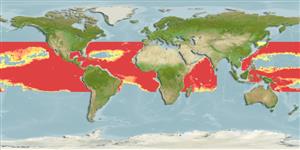Classification / Names
Common names from other countries
Main reference
Size / Weight / Age
Max length : 9.5 cm SL male/unsexed; (Ref. 4479)
Environment
Marine; bathypelagic; non-migratory; depth range 900 - 2000 m (Ref. 58302)
Climate / Range
Deep-water, preferred ?; 40°N - 20°S
Distribution
Eastern Atlantic: Madeira and Cape Verde. Western Atlantic: near Bermuda and Jamaica. Western Indian Ocean: 4°S, 60°E. Western Pacific: off Philippines. Eastern Pacific: between Hawaii and California, USA (37°-20°N), and also east of 115°W between 0° and 17°S.
Countries | FAO areas | Ecosystems | Occurrences | Introductions
IUCN Red List Status (Ref. 115185)
Threat to humans
Harmless
Human uses
More information
Common namesSynonymsMetabolismPredatorsEcotoxicologyReproductionMaturitySpawningFecundityEggsEgg development
Age/Size
Growth
Length-weight
Length-length
Length-frequencies
Morphometrics
Morphology
Larvae
Larval dynamics
Recruitment
Abundance
ReferencesAquacultureAquaculture profileStrainsGeneticsAllele frequenciesHeritabilityDiseasesProcessingMass conversion
Tools
Special reports
Download XML
Internet sources
Estimates of some properties based on models
Phylogenetic diversity index
PD50 = 0.6250 many relatives (e.g. carps) 0.5 - 2.0 few relatives (e.g. lungfishes)
Trophic Level
3.1 ±0.3 se; Based on size and trophs of closest relatives
Resilience
Medium, minimum population doubling time 1.4 - 4.4 years (Preliminary K or Fecundity.)
Vulnerability
Low to moderate vulnerability (34 of 100)
Price category
